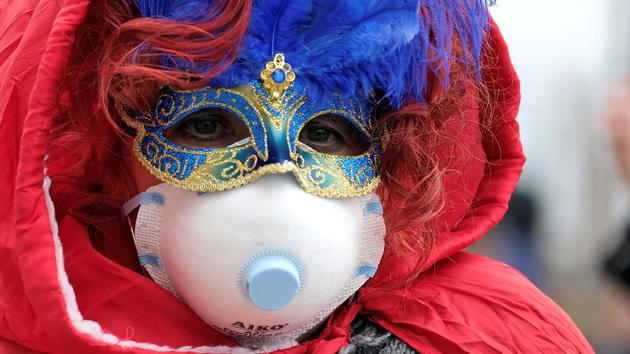First, let's clarify this: an "epidemic" is an "unusual and sudden increase in the number of individuals with a communicable disease existing in an endemic state in a given region or population". The "pandemic" is an "epidemic that extends to almost the entire population". Plague, smallpox, chorela ... Do you know the origin of these names? Le Figaro invites you to discover it thanks to the book Les epidémies, from the black plague to the influenza A / H1N1 (Dunod) by Jean-Pierre Dedet.
»READ ALSO - 2010-2020: these new words that tell the story of the decade
Justinian's plague
This is the name of this extremely contagious bacterial disease that is first found in "wild rodents (rats, merions, marmots, depending on the outbreak) whose responsible bacteria, Yersinia pestis , is transmitted by fleas" , as well as Jean-Pierre Dedet reminds us.
The Littré specifies that the term comes from the Latin pestis , "plague", or "contagious disease, epidemic" , notes Le Trésor de la langue française. In the sixth century and under the reign of the Byzantine emperor Justinian, the "first pandemic that can be linked with enough arguments to the plague" appeared , notes Dedet. It took three centuries and eleven epidemic waves for the "Justinian plague" to die out. The author specifies that Grégoire de Tours nicknamed it "disease of the elders" in his Histoire des Francs . And this, "in reference to the bubonic form" .
The Great Black Death
It only took five years for the "Great Black Death" to devastate Europe and "decimate about a quarter of the population" . "Probably from the highlands of Central Asia, it exploded in Kurdistan in the 1330s, then reached the shores of the Caspian Sea," says Dedet. In 1348, it reached the Genoa counter of Caffa. "According to a census ordered by Pope Clement VI in 1352, the plague has claimed 25 million victims among the Christian populations."
But why was it called "black"? "For Jacqueline Brossolet and Henri Mollaret, we must take the adjective figuratively," terrible "or" horrible ", and not literally, the color black" , explains Jean Vitaux in his book Histoire de la plague . In the translation of a work by J. Hecker published in Berlin in 1832, we find a strange explanation to say the least: "epidemic preceded by the appearance of a black comet according to an astrologer, presence of prodigious amounts of anthracites and black stones in the region where it originated, a disease that first struck the Saracens of Asia, and finally a black coloration of the body of plague victims, which is if not a legend, at least an exaggeration, ” summarizes Vitaux.
Cholera
Originally, this "strictly contagious, strictly human infectious" disease originated in India. As Dedet tells it , "it was at the beginning of the 19th century that cholera left India, using trade routes and following the rhythm of means of transport" . Between 1817 and 1992, cholera caused seven pandemics.
The word is borrowed from the Latin cholera "attested in the imperial era in the sense of illness which comes from bile" , notes Le Trésor de la langue française. It is from this term that the adjective "choleric" appeared which, in 1256, is attested in the sense of "bilious, subject to the inflation of bile" . At the beginning of the 13th century, the TLFI still specifies, was born "angry", "bilious". It took a century for this word to take on the meaning of "brought to anger".
Smallpox
Smallpox, or smallpox, is "one of the oldest known epidemic diseases. It is the only one that Man has succeeded in eradicating from the surface of the globe, thanks to the systematic vaccination of the world population ” . According to Dedet, it is established that the disease was already known to the inhabitants of India three thousand years ago.
According to Le Trésor de la langue française, the word comes from the Latin medical variola , "infectious disease" , diminutive of varius, "having small pox" , with the influence of Latin varius , "varied, variegated, spotted, speckled" . Indeed, smallpox is characterized by "an eruption of pustules forming crusts which, falling, leave depressed scars, especially on the face, and which have almost disappeared today thanks to vaccination".
Typhus
"Infectious, contagious disease caused by a rickettsia transmitted by the louse, characterized by high fever, a red rash (exanthema) and neurological disorders" , we read in Le Trésor de la langue française. In history, we observe with certainty the first typhus epidemic in 1489 in Spain, "where, during the siege of Granada, 17,000 men of the army of Catholic kings, died of a fever accompanied by exanthema" , Dedet notes.
The word is borrowed from the medical Latin typhus , itself borrowed from the Greek tyfos , "torpor, stupor, lethargy" , and properly "smoke, vapor" , derived from tyfein , "to burn" . As stated in Le Trésor de la langue française, the term was used by Hippocrates "to designate certain febrile illnesses accompanied by stupor" . Note that this disease was designated until 1835, by the expressions "camp fever," hospital fever "," prison fever "," because it was originally caused by the crowding of a large number of 'men in a narrow space'.
Yellow fever
As Dedet reminds us, yellow fever is one of the oldest diseases in the New World. Indeed, it already existed in the 11th century. It is transmitted by mosquitoes and is manifested by "hemorrhagic fever accompanied by acute hepatitis and joint damage which can generate renal failure".
Fever, this "morbid condition characterized by elevated body temperature and various physiological disorders" , comes from the Latin febris , which etymologists attach to the Greek phebomai , "to tremble, to fear" . It is called "yellow" because it is possible to observe in patients with this disease, yellowing of the skin and eyes.
Spanish flu
It is responsible for the deaths of 25 to 50 million people at the end of the First World War. Spanish influenza is "a highly contagious viral lung disease, most often occurring in the form of winter epidemics" . Its geographic and temporal origin remains mysterious.
As Serge Morand tells in his book A global history of infectious diseases , the Spanish flu was baptized thus "probably because the first statistics were published by Spain, one of the rare countries not to have taken part in the First World War". Originally, a "flu" is a "grip, grip" . As Le Trésor de la langue française points out, the use of influenza that occupies us here comes "from the fact that it is a disease that suddenly seizes".
You can also follow Figaro Langue française on Twitter .
»Ask all your questions about the French language through our Forum .
»Find our French language section on Le Figaro Store .
»Passionate about word games? Download our Figaro Games app .













